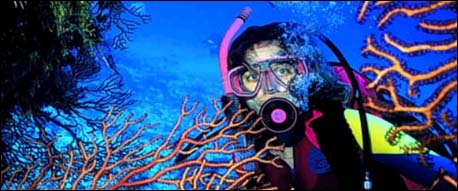
SPONSORED
LINKS
Equipments
Diving
equipment depends on the location of the dive, but
whether scuba diving or snorkeling, recreational divers
need several basic items. Which are a mask, snorkel,
fins, suits and air source devices.
A diving mask that covers the nose and eyes enables the
diver to see while underwater. A snorkel is a tube that
allows the diver to breathe while floating at the
water's surface. Fins that are worn on the feet let
divers propel themselves through the water.
Divers lose body heat 60 times faster underwater than on
land, because water conducts heat much more efficiently
than air does. To stay warm, scuba divers wear either a
wet suit or a dry suit, depending on water temperature.
Wet suits are usually worn in warm-water climates. A wet
suit is made of neoprene rubber and absorbs and traps a
thin layer of water, which the diver's body quickly
heats. In areas such as the North Atlantic or Pacific
oceans, where water temperature drops below 10░ C (50░
F), divers wear dry suits to keep from freezing. A dry
suit is made of waterproof materials that keep a diver
completely dry. If water temperatures are extremely low,
divers wear extra clothing underneath the suit.
To breathe underwater, scuba divers wear a metal tank
filled with compressed air, and a regulator that
attaches to the tank. The regulator reduces the pressure
of the air to match the surrounding water pressure, so
that the diver can breathe the air comfortably. The
regulator also distributes the air among four hoses. One
hose delivers air to a mouthpiece, through which the
diver inhales and exhales. Another hose from the
regulator attaches to an adjustable air bladder called a
buoyancy compensator (or control) device (BCD or BC),
which the diver wears as a vest. By adding air to the
BCD, the diver becomes more buoyant and rises. By
releasing air, the diver becomes less buoyant and sinks.
With minor adjustments of air, the diver can achieve
neutral buoyancy. A third hose attaches to pressure
gauges that divers use to monitor how much air remains
in the tank. A fourth hose attaches to a backup
breathing device called an alternate air source, or
octopus.
Divers also wear a belt with lead weights to help them
descend and stay underwater. The weights are spaced
evenly around the belt for balance. Most divers carry
from 5 to 20 lb (2.3 to 4 kg) of weight, depending on
their body weight, the suit they are wearing, and where
they are diving (buoyancy is greater in saltwater than
in fresh water). A quick-release buckle enables the
diver to shed the belt and rise to the surface in an
emergency.
Emergency equipment includes a dive knife, in case the
diver becomes entangled in fishing line or marine
plants, and whistles, lights, or signaling devices, in
case the diver is lost or swept out in a current. Divers
should also have a tank of oxygen onboard, along with a
marine radio and a first aid kit.
Submersibles
Submersibles are pressurized vehicles that maintain
surface air pressure inside while they descend deep into
the ocean. The most common type of submersible is a
submarine. Smaller submersibles are used in deep diving
to transport hard-hat divers to and from workstations.
Submersibles are used in deep-sea exploration,
scientific studies, and military operations.
OTHER PAGES
10

|